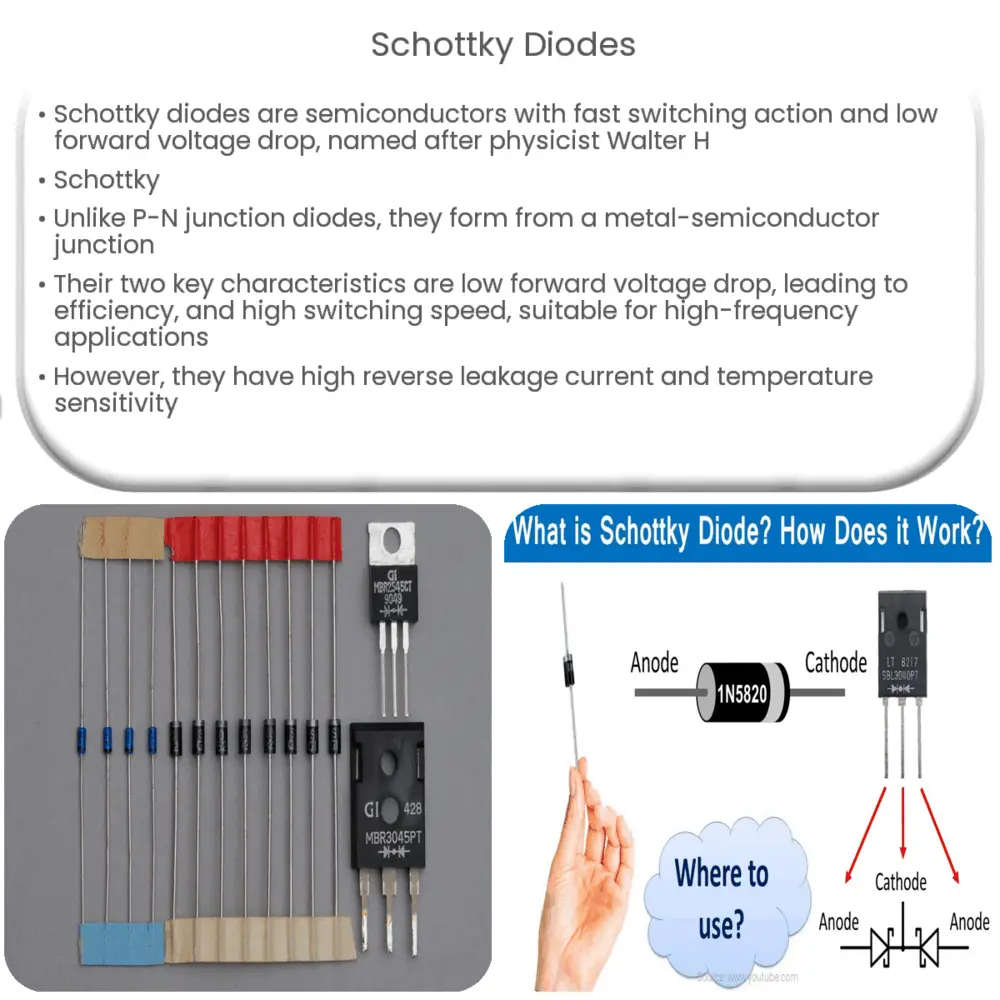Explore the world of Schottky diodes, their structure, unique characteristics, applications, and the pros and cons in electronics design.

Introduction to Schottky Diodes
A Schottky diode, also known as a hot-carrier diode or Schottky barrier diode, is a semiconductor diode distinguished by a very fast switching action and low forward voltage drop. Named after the German physicist Walter H. Schottky, this diode is a critical component in many electronic circuits, including power applications and high-speed switching circuits.
Structure of Schottky Diodes
The Schottky diode differs significantly from the typical P-N junction diode in its structural composition. Instead of a P-N junction, a Schottky diode is formed by the junction of a semiconductor with a metal. The metal side acts as the anode, while the semiconductor acts as the cathode.
- Anode: The metal side, made from a low-work-function metal, such as molybdenum, platinum, chromium or tungsten.
- Cathode: The semiconductor side, typically N-type silicon.
The contact between the metal and N-type semiconductor creates a barrier, known as the ‘Schottky Barrier.’ This barrier is responsible for the diode’s unique characteristics.
Key Characteristics of Schottky Diodes
What sets the Schottky diode apart from other types of diodes are its two key characteristics: low forward voltage drop and high switching speed.
- Low Forward Voltage Drop: Unlike conventional P-N junction diodes, Schottky diodes have a low forward voltage drop, typically between 0.15 to 0.45 volts. This makes them highly efficient, as less energy is wasted in the form of heat.
- High Switching Speed: Schottky diodes can switch on and off very quickly. They don’t have a charge storage period, making them free from the problem of reverse recovery time that’s common in standard diodes. This makes them ideal for high-frequency applications.
The combination of high efficiency and fast switching makes the Schottky diode an essential component in a wide range of applications, including power rectification, voltage clamping, and as a protective device in circuits.
Applications of Schottky Diodes
Schottky diodes find their usage in a variety of applications, thanks to their unique characteristics. Some of these applications include:
- Power Rectification: They are commonly used in power supplies due to their low forward voltage drop, which contributes to higher system efficiency.
- Voltage Clamping: Schottky diodes are used to protect circuits from voltage spikes.
Continuing with the applications:
- Reverse Current and Discharge Protection: They are often used in battery-powered systems due to their ability to prevent reverse current flow.
- High-Frequency Applications: The fast recovery time of Schottky diodes makes them suitable for high-frequency applications, such as in radio frequency (RF) mixers and detectors, as well as in switching mode power supplies and DC-DC converters.
Advantages and Disadvantages of Schottky Diodes
As with any electronic component, Schottky diodes have both advantages and disadvantages which must be considered when designing a circuit.
- Advantages:
- Low forward voltage drop resulting in lower power dissipation and hence increased efficiency.
- High switching speed due to the absence of a charge storage period.
- They can handle high levels of current.
- Disadvantages:
- High reverse leakage current, which increases with the rise in temperature.
- They have a lower reverse voltage rating compared to conventional diodes.
- Their performance is highly sensitive to changes in temperature.
Conclusion
In conclusion, Schottky diodes, with their unique combination of low forward voltage drop and high switching speed, are a crucial component in modern electronic design. They play a significant role in improving the efficiency of power supplies and enabling high-speed operations. However, like any component, their advantages come with trade-offs, such as a higher reverse leakage current and sensitivity to temperature changes. Therefore, understanding these characteristics is vital for engineers and designers when choosing the appropriate diode for their specific applications. Despite their limitations, Schottky diodes continue to be invaluable in the fast-paced, high-efficiency demands of today’s electronic world.

